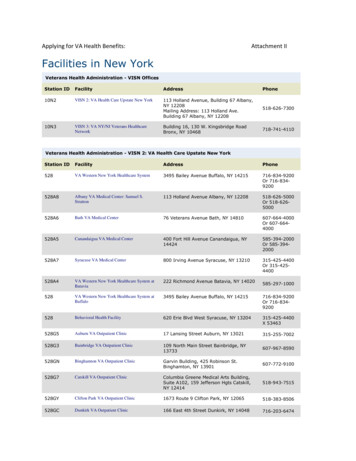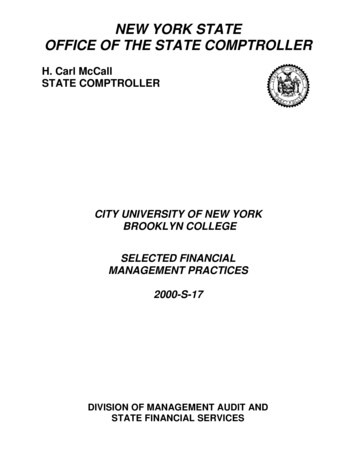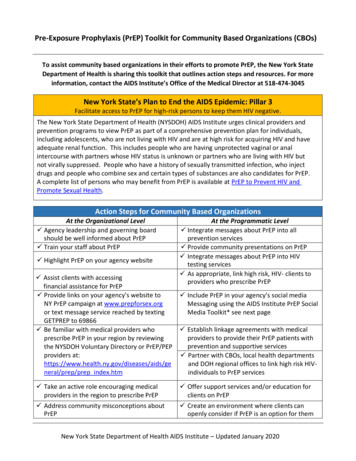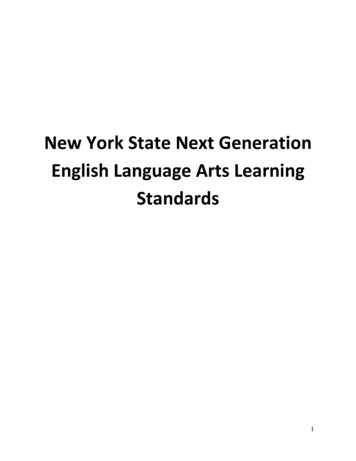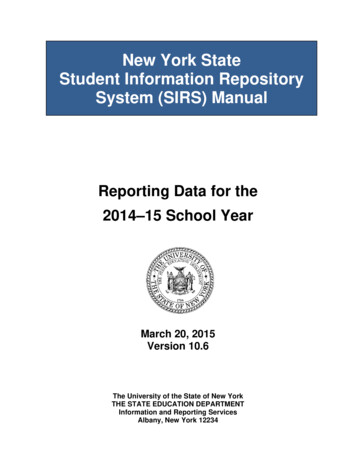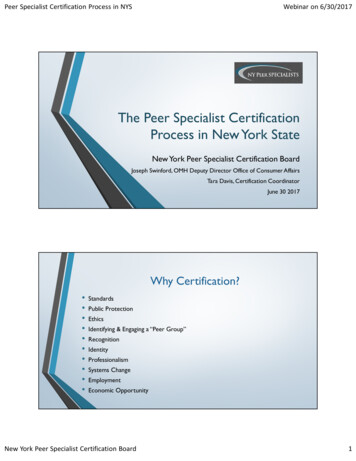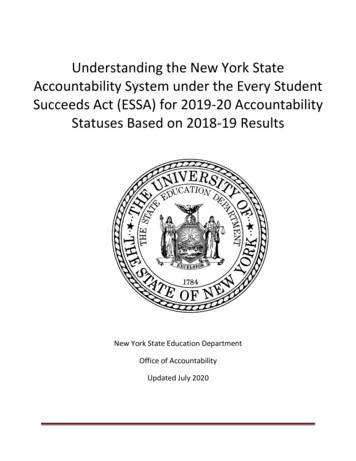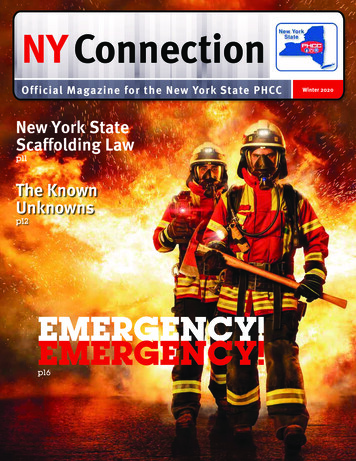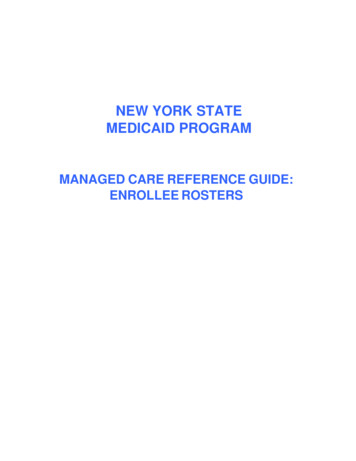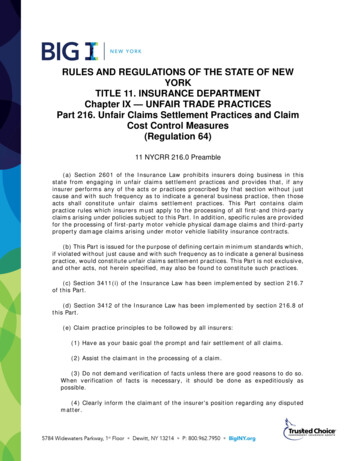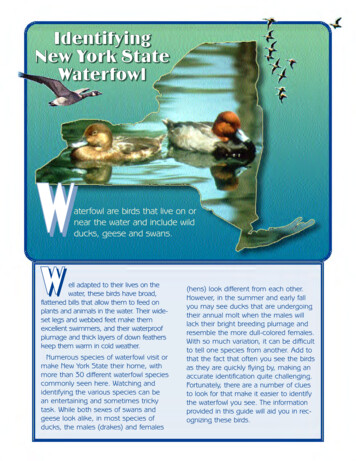
Transcription
IIdentifyingdentifyingNewNew YorkYork StateStateWaterfowlWater fowlWaterfowl are birds that live on ornear the water and include wildducks, geese and swans.Well adapted to their lives on thewater, these birds have broad,flattened bills that allow them to feed onplants and animals in the water. Their wideset legs and webbed feet make themexcellent swimmers, and their waterproofplumage and thick layers of down featherskeep them warm in cold weather.Numerous species of waterfowl visit ormake New York State their home, withmore than 30 different waterfowl speciescommonly seen here. Watching andidentifying the various species can bean entertaining and sometimes trickytask. While both sexes of swans andgeese look alike, in most species ofducks, the males (drakes) and females(hens) look different from each other.However, in the summer and early fallyou may see ducks that are undergoingtheir annual molt when the males willlack their bright breeding plumage andresemble the more dull-colored females.With so much variation, it can be difficultto tell one species from another. Add tothat the fact that often you see the birdsas they are quickly flying by, making anaccurate identification quite challenging.Fortunately, there are a number of cluesto look for that make it easier to identifythe waterfowl you see. The informationprovided in this guide will aid you in recognizing these birds.
Identifying NYS WaterfowlThe best way to become better at identifying waterfowl is topractice seeing them in their own environment. Knowing thehabitat preferences, food habits, molting schedules, and flighthabits for various species makes it easier to locate and identifythem. Learn what waterfowl species are most common in yourarea and what time of year they are likely to occur. Of themore than 30 species regularly seen in NY, only seven arelikely to be seen during the summer. So, grab your binoculars,field guide, and your family and head down to your local river,bay, or marsh and have fun getting to know your waterfowl.What to look lors — Notice the colors you seeHabitat — First, consider whereon the birds, particularly thehead and wings. Eachspecies has its ownunique markings.you see the waterfowl. Are they in alarge open body of water (like a riveror lake), on a small pond or marsh,or feeding in crop fields?speculum(puddle duck)I)I(Flight Pattern —speculumDo the birds fly in aparticular pattern?Are they in a single,straight line close tothe water; in V's;or in loose flockformations?(diving duck)Size and Shape — Pay closeattention to the size andthe shape of the birds.For example, swansand geese are muchlarger than ducks,and mallards arelarger than teal.Pintails - looseflock formationMergansersstraight line,close to waterCanada GeeseV-formationSound — Do you hearthem? Not all geesehonk — some cackle,yelp or croak. And not allducks quack — somewhistle, growl or squeal.
Major Groups of WaterfowlDucks:There are two basic types of ducks — puddle(or dabbling) ducks and diving ducks.Puddle Ducks — Puddle ducks are commonly found inshallow marshes or small rivers. They have colored wingpatches (speculum) that are usually iridescent. They prefer to feed on or just below the surface of the water bydabbling or tipping up with their rump pointing up. Theywalk well on land and are often seen feeding in croplands.They sit high with their tail out of the water and can takeoff directly from the water to flight. Puddle ducks includemallards, black ducks, wood ducks, teal and pintails.Diving Ducks — Diving ducks are usually found on largerbodies of water. Diving ducks are better at diving underthe water than puddle ducks. Their wing patches are usually dull white or grey colored. Their legs are positioned farback on their body and their larger feet help make thembetter underwater swimmers. However, the position oftheir legs makes it more difficult for them to walk on landso you will seldom see them feeding in farm fields or resting on shore. Most diving ducks need to run along the surface of the water to gain speed for flight. Diving ducksinclude scaup, canvasback, redhead, goldeneye, bufflehead, mergansers, and scoters.Geese and Swans: Geese and swans are distinguished from other waterfowl by their large size. Malesand females look alike.Geese — Geese are larger, heavier, and have longer necksthan ducks. During migration times, you may see largeflocks (sometimes numbering in the thousands) flying in aline or in V-shaped formations in order to reduce wind resistance. Geese include Canada geese, snow geese, and brant.Swans — Swans are the largest of all waterfowl and havemuch longer necks than geese. Adults of these threespecies are completely white. Swans you may see in NYSinclude mute swans, tundra swans, and trumpeter swans.Viewing WaterfowlIf you know where, when and how to look for waterfowlyou will see more birds. Here are a few guidelines forsuccessfully viewing waterfowl: Look for waterfowl in ponds, lakes, streams, marshesand bays. Watch for waterfowl during their spring and fall migrations. Early morning or evenings are the best times ofthe day to view these birds as they fly off and land onthe water. Move slowly and quietly. Waterfowl see colors verywell, so wear a hat and clothing that blends in withyour surroundings. Resist the urge to look up at theEdward Jakubowskisky exposing your face and neck, instead move youreyes and head slowly. The use of man-made or natural blinds (vegetation) willhelp keep you concealed and improve your chances ofseeing more birds. Watch and listen carefully for movement in the air,water and surrounding vegetation. Bring your field guide and binoculars to help you identifybirds and their calls.Finally, just relax and enjoy waterfowl watching. Soonyou’ll know how to identify many of New York’s waterfowl.
A Sampler of New York’s Waterfowl SpeciesPuddle DucksMallards are the most common duck year-round inNY, found in a wide variety of habitats, including urbanpark ponds. The drake has a metallic green head with awhite neck ring,chestnut-colored chest,and white tailwith blackcurled centraltail feathers.the hen's. The hen is dark brown with tan and greysides and has a white teardrop-shaped ring around hereye. Drakes make a loud "whoo-wett" sound when distressed and a high-pitched whistle in courtship. Hensmake a squeeling "crrek-crrek" sound.Blue-Winged Teal are easy to identify by their smallsize and erratic flight. Both drakes and hens have slateblue wing patches and a green speculum. Drakeshave a white crescent on each side of theirMike AnichThehen is a mottled brown color.The wings of both the drake and hen havea violet metallic speculum bordered by twowhite bars. Mallards usually fly in smallflocks. Drakes make a low "kwek" or "yeeb"sound. The hens make the well-known loud quack.Black Ducks are similar in size to the mallard, butthey are darker overall and at a distance look black. Thedrake and hen are identical with the head and neck alighter brown. Adark streakruns throughthe eye fromthe billacross thecheek. Theunderside oftheir wings arewhite and thecontrast betweenthe white on thewings and darkbody is a good identification clue when seeing the birds in flight. Black duckwings have a violet-blue speculum and lack the twowhite bars present on the mallard's wings. Adults makesounds similar to mallards.Wood Ducks have a crested head, broad wings andrectangular tail. The drake is beautifully colored with aniridescent greenEric Dresserand purplehead, back,wings andtail. Thedrake's crestis muchmore pronounced thanEdward Jakubowskiface. The hen lacksthe facial crescentand is a mottledbrown color. Drakesmake whistling"peep" sounds. Hensmake a faint quack.Green-Winged Teal are small pigeon-sized ducks.Both drakes and hens have a green speculum. The drakehas a rusty-coloredDeanne C. Cunninghamhead and a brightgreen slash acrossthe eye. A whitevertical bar separates the buff-colored chest fromthe greybackand sides.The hen isa mottledbrown color.Drakes makeshort whistle and peeping sounds. Hens make ahigh-pitched quack.Pintails (Sprig ) are large, mallard-sized ducks andcan be easily identified by their long, pointed tail feathers and long, slender profile in flight. The drakehas a chocolate brown head with awhite stripe running up bothsides of its neck. His throat,chest and belly are white. Thehen's long, slender shape isnot as distinct as the drake's, but she
still has a longer tail than most ducks. The hen is a mottled brown color. Drakes make a double tone "prrip,prrip" whistle. Hensmake low quacks.Diving DucksScaup (bluebill, broadbill ) are often seen inlarge groups (called rafts) on large bodies of water.Both drakes and hens have a blue-grey bill with a blacktip and have a broad white stripe on the trailing edgeof the wing.The Lesser Scaup is themost common species ofdiving duck. The drake'shead has a purplish-blacksheen and often appearsangular. The drake'sneck, head,chest andrump areblack and thesides and undersides are pale grey towhite. The hen is darkbrown with whitish undersides. She has a distinctivewhite patch at the base of herbill. The wings of both the drake and the hen are charcoal brown with a long white patch or stripe runningdown the trailing edge of the wing. Drakes make a low,single note whistle or a loud quack. Hens make purringor low growling sounds.Greater Scaup are slightly larger than the lesserscaup and are verysimilar in appearance. The drake'shead has a greenish-black sheenand is morerounded in shape.The wings aresimilar to the lesserscaup's, but the coloration is more brownand the white wing patch or stripe is longer. Drakesmake a "scaup, scaup" sound. Hens are usually silent.The Canvasback is the fastest flying duck. It is easilyidentified by its "doorstop" shaped head. The drake'shead is red with along, black bill. It has a greyish-whiteback and sides. The hen is buff-coloredwith a rusty-brown head and chest, anddusky-grey back. Canvasbacks usually shift from wavinglines to temporary V's in flight. Drakes make a lowcroak, peep and even growl. Hens quack.The Redhead has a more rounded head and shorterbill than the canvasback. The drake hasa reddish head, butis slightlysmaller and has a darker back andsides. The bill is blue-grey with a narrow white ring located behind theblack tip. The hen has a reddishbrown head and breast with drabbrown back and sides. Drakes "purr" and make a catlike"meow" sound. Hens make a high, loud "squak" and asoft growling sound.CommonGoldeneyeThe(Whistler ) is named forits gold-colored eye. Thedrake’shead isblackwith agreenishsheen and has a white round spot in frontof the eye. A row of black and whitefeathers separate the black back and rumpfrom the white chest and undersides. Thehen's head is dark brown with no facial spot. Her sidesand back are greyish-brown with a white chest. Thewings of the common goldeneye whistle in flight.Drakes make a nasal double-note "pee-ik" sound. Hensmake a low quack.
The Bufflehead (Butterball ) is a very small duckwith a rounded shape. The drake's head is black with agreenish-purplesheen and has awhitewedgeshapedEdward Jakubowskipatch behind theeye. The hen's head is dark brown with a small whitepatch behind the eye. Her back is dark brown with greyish sides and a white belly. They are usually silent, butdrakes make a hoarse "squeek" sound and hens make aharsh quack.Mergansers are streamlined-shaped ducks with longpointed bills with saw-edge mandibles used for graspingfish. They are often seen on rivers and large streams.Mergansers usually fly in a single straight line close tothe water.The Common Merganser drakehas a dark green head with nocrest, a black backand whitesides and belly.The hen has abrown crestedEdward Jakubowskihead. Her back, chest and sides are grey and her bellyis white. Drakes make low "croak" sounds and hensmake a harsh, gutteral sound.The Red-Breasted Merganser drake has a crested green head, a reddish-brown chest, ablack back and awhite belly. Thehen has a lesspronounced crestand reddishbrown head. Theyare usually silent,but make ahoarse "croak" sound.These birds are primarily seen on coastalwaters in winter.TheHooded Merganser is the smallest of themergansers. The drake has a pronounced fan-shaped, black and whitecrest. His back is black with whitestripes with brownish sides. The henhas a reddishbrown crestedhead and darkback. They makelow grunting orcroaking sounds.Edward JakubowskiScoters are sea ducks commonly seen in coastalwaters and around the Great Lakes.TheWhite-Winged Scoter (Sea coot )is the most numerous of the scoters in NYS.The drake is all black except thewhite wing patch and the smallwhite crescent around the eye. Hisorange-yellow bill is knobbedand has a reddish tip. Thehen is slightly lighter in colorand has a smaller whitespeculum. She has tancolored cheek patchesand a greyish bill with noknob. They fly in a stringyline or V-formation, andmake bell-like whistlesounds.Geese and SwansCanada Geese are probably the most easily recognized waterfowl in NYS. Theirlarge size, black neck andhead with white cheekpatches extending under thethroat, and brownish-greybody make them easy toEdward Jakubowskiidentify. They fly in long strings in V-formation. Canadageese make a loud, deep "honking" sound.Most Adult Snow Geese have an all white body andblack wing tips. Young often have an ashy-gray appearance, and some adults, called “blue geese,” have verydark bodies with just a white head. Snow geese have ashorter neck than swans.Very noisy birds, their call isa shrill honk, higher-pitchedthan the Canada goose.
The Tundra Swan (Whistling ) has an allwhite body, black feet, and a small yellow spotat the base of its black bill. Tundra Swans makehighpitchedcooingsounds.The Mute Swan is probablythe most familiar swan in NYSwith its S-shaped curved neck. Itwas an import to North Americafrom Europe, but has establishedbreeding populations. Adultshave a
Redhead has a more rounded head and shorter bill than the canvas-back. The drake has a reddish head, but is slightly . smaller and has a darker back and sides. The bill is blue-grey with a nar-row white ring located behind the black tip. The hen has a reddish-brown head and breast with drab brown back and sides. Drakes "purr" and make a catlike "meow" sound. Hens make a high, loud "squak" and .
